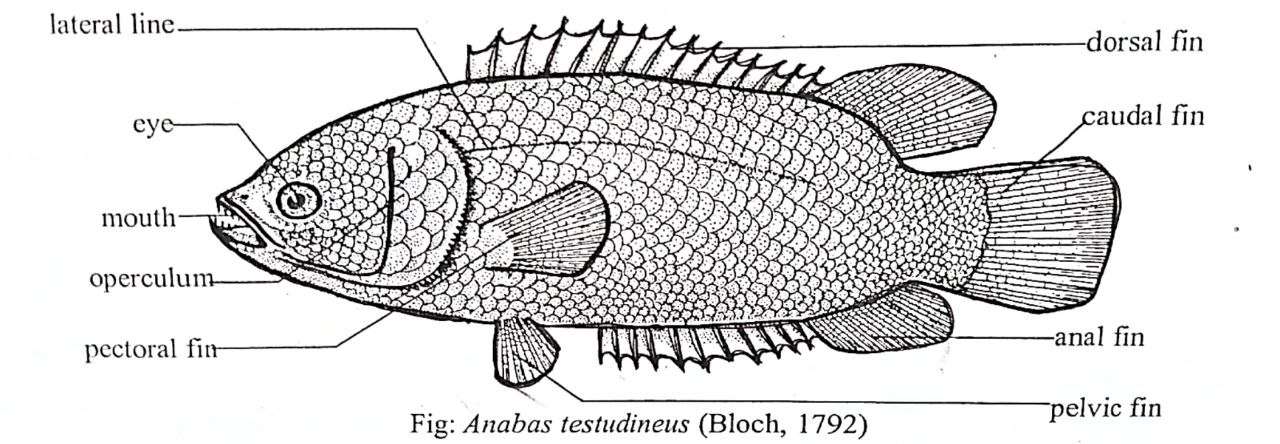In this article of Anabas, we will learn 1. The systematic position, 2. Habit and Habitat, 3. Food and Feeding, 4. Diagram of Anabas, 5. Identifying Characters of Anabas, 6. Breeding/Reproduction, 7. Ecological Importance and 8. Economic Importance. The common name of Anabas is “Climbing Perch”, “Koi”, etc.
Systematic Position of Anabas
Kingdom: Animalia
Phylum: Chordata
Subphylum: Vertebrata
Class: Osteichthyes
Order: Perciformes
Family: Anabantidae
Genus: Anabas
Species: Anabas testudineus
Habit and Habitat of Anabas
- They are native fish of South and East Asia.
- Found in mainly Bangladesh, India, Myanmar, Srilanka, Indonesia, Malaysia, Thailand, Cambodia and the Philippines.
- They live in fresh and brackish water.
- They are found in rivers, canals, lakes, ponds, paddy fields, etc.
- Climbing Perch have an accessory air-breathing organ, the labyrinth organ.
- The labyrinth organ is located above the gills.
- With the help of this labyrinth organ, they can tolerate low oxygen levels and a long period out of the water if they are kept moist.
- They can pass 6-8 hours outside the water with the help of a labyrinth organ.
- Anabas is able to walk on land by spines of the operculum.
Food and Feeding of Anabas
- They are carnivorous.
- They are predatory on shrimps, ostracods, gastropod shells, and young fishes.
- They feed on mainly insects, insect larvae, fry fishes, etc.
- Sometimes they come to the land and walk with the spines of the operculum in search of earthworms.
Diagram of Anabas/Climbing Perch

Identifying Characters of Anabas
1. Body elongated and laterally compressed.
2. Body length is 15-20 cm.
3. Mouth is anterior and lower jaw slightly longer.
4. Head is conical containing large eyes, nostrils, and mouth.
5. Teeth are present.
6. Teeth are villiform type.
7. Five types of fins present and they are dorsal, pectoral, pelvic, anal, and caudal.
8. Dorsal and anal fins are long.
9. Base of soft dorsal fin, pectoral fin, soft anal fin and caudal fin are covered by scales.
10. Body color dark to pale greenish, very pale below, back dusky to olive.
11. Body form variable, affected by age and amount of food consumed.
12. Scales present on the body.
13. Scales are large and ctenoid. They are regularly arranged and ciliate.
14. Lateral line present but interrupted.
15. Dorsal, pelvic, and anal fin rays are modified to spines.
16. Body is divided into a head, trunk, and tail.
17. Caudal fin is not forked and is perfectly symmetrical.
18. Fin formula: D. 17-18 /8-10, P1. 15, P2. 1/5, A. 9-10/9-11 (Bhuiyan, 1982).
Breeding / Reproduction of Anabas
- Breeding season starts in April and continues till July.
- Eggs are pelagic.
- Fertilization is external.
- Eggs float over the surface.
- Eggs hatch at 28.5 degree Celsius temperature.
- It takes almost 18 hours to hatch the eggs.
- Females do not exhibit parental care. The males exhibit parental care.
Ecological Importance of Anabas
- They are the part of freshwater ecosystem.
- They live in rivers, canals, streams, ponds, paddy fields, etc.
- They are carnivorous.
- They usually feed on insects, insect larvae, fry fishes, etc.
- Sometimes they are predatory on shrimps and small fishes.
- They are eaten by monster fishes, aquatic birds, and other aquatic animals like snakes.
- They are also eaten by humans.
Economic Importance of Anabas
- It has a very high demand in the local fish market.
- This species is very important as a food fish in Bangladesh, India and other countries.
- This fish is very suitable for cultivation in ponds and rice fields. Many farmers cultivate them also.
- Fish farmers cultivate this fish and sell them to the local market and putting an important role in the country’s GDP.
- This fish has recently introduced as ornamental fish and many native fishkeepers keep them as pets.
——–THE END———
Read more:
- Ompok pabda – Habitat, Characters, Economic Importance and Diagram.
- Mystus cavasius – Diagram | Habit and Habitat, Identifying Characteristics, Economic and Ecological Importance
- Mystus tengara – Habit and Habitat, Identifying Characteristics, Economic and Ecological Importance.
- General Characters of All Classes of Vertebrates.
Reference:
2. Anabas wiki

Md Ekarm Hossain Bhuiyan is a dedicated zoology graduate with a profound passion for the study of animal life. He completed his primary and secondary education at Ispahani Public School and College, renowned for its commitment to academic excellence. He then pursued his secondary education at Government Science College. After that he achieved graduation at Department of Zoology, Jagannath University. His educational background and enthusiasm for zoology position him to make meaningful contributions to the field of biological sciences in Bangladesh.